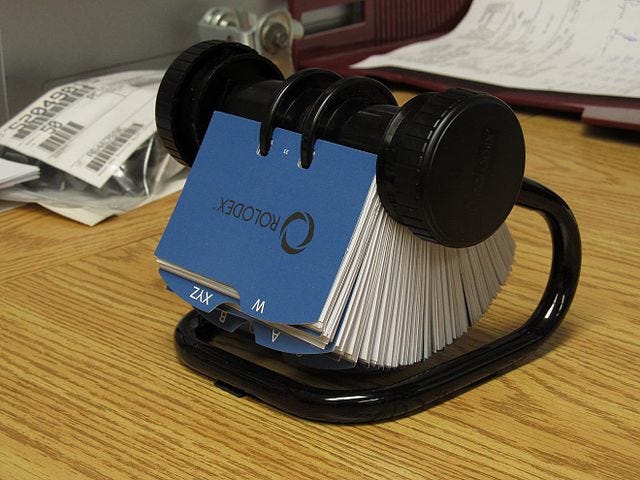Many firms buy a CRM system — but then fail to make the most of it.
Here’s the point… Most growing professional services firms can benefit from a tool to organize how they win new work. Nowadays, this is usually a CRM (Customer Relationship Management) system. So they get one and it doesn’t go well for many of the users. It doesn’t have to be like that, and you can do something about it today.
The Rolodex was invented in 1956 by a Danish engineer. As an aside, here’s my favorite part of the Wikipedia information:
A Rolodex is a rotating file device used to store business contact information. Its name is a portmanteau word of rolling and index and desk.
Portmanteau. Great word! A word that is made up of parts and meanings of other words. As an English major, I can cross the use of portmanteau off my literary bucket list. But I digress…

Visions of rotary telephones, old metal desks, and cigarette-smoking salesmen come to mind when you think of the Rolodex. But the most important — and relevant — aspect of a Rolodex was, and still is, that it’s part of a system. And it was most likely born out of necessity for busy people who needed a better tool that didn’t get in the way of their day-to-day activities.
All successful people have systems and processes in most aspects of their lives — work or otherwise. These systems include both tools (paper, pencils, hammers, computers, software, etc.) and ritualized behaviors. The tools and behaviors come together to create a process that is second nature to the individual. We all have these. You get it.
The most challenging part of the implementation of any new system is the behavior part. We have all been through new software versions or new ways of doing things with new employers or new customers. Again, you get it.
When it comes to a CRM system, there is an added element that makes a successful implementation even harder. Beyond the tool and the associated new behaviors, there is huge resistance to introducing a new process between a consultant/architect/engineer and their customer. Furthermore, this new system takes that Rolodex sitting on the desk and shares it with the rest of the organization. I can picture Milton from the movie Office Space and his cherished, red Springline stapler — no one is ready to share their Rolodex and definitely not prepared to give it up.

There is no perfect tool that does its job without the necessary, associated behaviors. People must use it — and want to use it — for it to deliver on the initial promise of greater productivity, better organization, or whatever bullet points were listed under the word “benefits” on the website. And there is no silver bullet to fix all of the issues that can arise.
What I do know is that organizations who seek to implement a new system of any kind must prioritize the associated behaviors that support a new tool like a CRM system. Meaning that shifting behaviors should come first, not last. Here’s what that means.
The individuals involved with developing new business should create and maintain a list of 50 “most important” contacts. On a piece of paper. With a spreadsheet. It doesn’t matter, just as long as it works.
These people should also outline a simple 1–2–3 step process — just a few steps — that introduces a logical order for a sales process. Again, it doesn’t matter if it’s on Post-it notes or on their iPhone. And there doesn’t need to be a big consensus on how it’s done. The goal is to create some kind of system with associated behaviors.
Lastly, there needs to be some rigor behind all of this. Weekly meetings. Accountability. Goals. Progress reviews. Hopefully no arm-twisting, but definitely some shared responsibility and focus on growth.
Once these individuals start to do this, they will quickly learn that they need help, either from a new tool or with a new organizational process or both. This creates a demand — a need — for a CRM system. Without a need, adoption of the new tool and behaviors will be an uphill struggle.
One last awesome word adventure from the Rolodex Wikipedia page:
The name rolodex has become somewhat genericized for any personal organizer performing this function, or as a metonym for the sum total of an individual’s accumulated business contacts.
Metonym. Another great one! I’ll let you go look that up yourself… And have a bit more respect for your grandfather’s Rolodex next time you talk about “the good old days.”